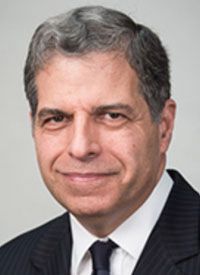Article
Nivolumab/Ipilimumab Shows Intriguing Clinical Activity in Metastatic Sarcomas
Author(s):
Gary K. Schwartz, MD, discusses the clinical findings with the combination of nivolumab and ipilimumab in patients with dedifferentiated liposarcoma and undifferentiated pleomorphic sarcoma.
Gary K. Schwartz, MD

In dedifferentiated liposarcoma (DDLS) and undifferentiated pleomorphic sarcoma (UPS), the primary end point of 6-month response rate was met with the combination of nivolumab (Opdivo) plus ipilimumab (Yervoy), according to Gary K. Schwartz, MD, who added that further research is needed to determine genomic and clinical biomarkers of response, resistance, and toxicity.
Results from the phase 2 Alliance A091401 trial presented during the 2020 ASCO Virtual Scientific Program showed that the overall response rate (ORR) with nivolumab plus ipilimumab was 28.6% in patients with UPS and 14.3% in patients with DDLS versus 7.7% and 6.7% with nivolumab alone, respectively. In a gastrointestinal stromal tumors (GIST) cohort, neither the combination nor nivolumab led to a confirmed response.
Furthermore, in the DDLS cohort, the median progression-free survival (PFS) was 4.6 months with nivolumab alone versus 5.5 months with the combination and the median overall survival was 8.1 months with nivolumab monotherapy versus 13.1 months with nivolumab/ipilimumab. In the UPS expansion cohort, the median PFS was 1.5 months versus 2.9 months with nivolumab and nivolumab/ipilimumab, respectively. The median OS was 6.6 months with nivolumab monotherapy and had not yet been reached with the combination. In the GIST cohort, the median PFS of 1.5 months with nivolumab alone versus 2.9 months with the combination, and the median OS was 9.1 months and 12.2 months, respectively.
“In this trial, we learned that some subtypes of sarcoma are more sensitive to immunotherapy, such as DDLS and UPS; however, the numbers are relatively [small],” said Schwartz. “These data suggest that the combination of ipilimumab plus nivolumab is superior to nivolumab alone. Furthermore, we saw relatively low treatment-related adverse effects (TRAEs), at about 10% to 15%.”
In an interview with OncLive, Schwartz, a professor of medicine, chief of the Division of Hematology/Oncology, and deputy director of Herbert Irving Comprehensive Cancer Center at Columbia University Medical Center, discussed updated results from the Alliance A091401 trial in patients with unresectable or metastatic sarcoma.
OncLive: Could you provide a background of the Alliance A091401 trial in patients with metastatic sarcoma?
Schwartz: The Alliance A091401 trial is a phase 2 study which is comparing nivolumab alone versus nivolumab plus ipilimumab in a randomized fashion for patients with advanced sarcoma. The actual study was first presented at the 2017 ASCO Annual Meeting and results were published in the Lancet Oncology in 2018 by Sandra P. D’Angelo, MD, of Memorial Sloan Kettering Cancer Center. The original paper showed that the combination of nivolumab plus ipilimumab resulted in higher response rates than just nivolumab alone. In the original study design, it appeared that there are several subtypes of sarcoma, particularly UPS and liposarcoma, for whom there is an increased response rate relative to other subtypes. In the original study design, there is no particular sarcoma subtype that was included because, at that time, no data indicated that one subtype would have a superior outcome to another subtype. As such, patients with all subtypes of sarcoma were included; this is complicated because sarcoma is a disease of probably 60 different subtypes, all of which are biologically different and have different outcomes.
When we did the study in 2017, we were curious to know whether one subtype would have a superior outcome over another. However, from the first study published in 2018, it appeared that the UPS and the DDLS subtypes would have superior outcomes. Data from the follow-up study, which were presented during the 2020 ASCO Virtual Scientific Program, examined these 2 expansion cohorts. In addition, we followed a third cohort, those with GIST tumors; this subtype was not assessed in the original study, but we felt it did merit the assessment of whether a benefit to ipilimumab or the combination existed in patients with this particular subtype of sarcoma.
What were the findings of this study presented during the 2020 ASCO Virtual Scientific Program?
The results suggest that the combination of ipilimumab plus nivolumab is superior to nivolumab alone, but the numbers are quite small. It's a randomized study. The major end point of the trial was to show 2 confirmed responses in at least 12 evaluable patients. In the randomization, both the DDLS and the UPS sarcoma subtypes showed at least 2 responses among 12 patients in each arm, which was superior to the single-agent nivolumab arm. In addition, not only was response a bit higher, again, we're talking small numbers, 7% versus 14% and 8% versus 14%, but trends also favored improvement in OS and PFS.
Now, as a caveat, the studies were not powered to examine these differences in a statistical fashion. However, these are trends were interesting and notable for both PFS and for OS in both the DDLS and UPS subtypes. GIST is one of the more common sarcomas in the United States, but what about immunotherapy [in these patients]? This had been an unanswered question until we put it to the test in this particular study. Unfortunately, the study was stopped early; we needed to see at least 1 response among 9 patients in either the single-agent or the combination arms and we saw no responses, so no partial or complete responses.
In addition, the study was complicated by increased TRAEs, which were significant in the combination arm. In the setting of no responses and increased TRAEs, which were mainly immune-related toxicities, that arm was terminated at 9 patients rather than going beyond the first stage. However, we did learn that, although no increase in responses was observed, there was a suggestion of improvement in both PFS and OS for the combination, indicating that some patients with GIST had stabilization of disease that was not reflected by a response by RECIST criteria, which was used in the study.
The study design for a sarcoma used a lower dose of ipilimumab, which we call the “sarcoma dosing.” For melanoma, the standard dose is 3 mg/kg of ipilimumab and 1 mg/kg of nivolumab. For this study, we did the opposite. We gave a full dose of nivolumab at 3 mg/kg and 1 mg/kg of ipilimumab. With that reduction in dosing of ipilimumab, it did greatly reduce the immune-related AEs in the DDLS and UPS subgroups, making this a much safer approach for patients with sarcoma.
Does the value of ipilimumab merit the risk of increased immune-related toxicities? In melanoma, we remain concerned because studies now suggest that it doesn't matter what dose of ipilimumab we use. However, in this study, we clearly use a lower dose of ipilimumab, showed reduce toxicity, and still improved benefit with regard to response rate, OS, and PFS.
Where should future research be focused?
We have only just started to scratch the surface in sarcoma. Most sarcoma doctors treat sarcoma and melanoma. Over the past decade, we learned about the value of immunotherapy. In melanoma, we've gone from incurable to curable cancer. Unfortunately, in sarcoma, despite the suggestions of responses, and even suggestions of improvement in OS and PFS, none of these [results] have really been that impressive. We have a lot to learn.
What is it about sarcoma that makes it different than melanoma? We know melanoma is a hot tumor, it has a lot of tumor mutational burden (TMB), high PD-L1 expression, and they're very inflamed. In sarcoma, if you look at the relative level of TMB and PD-L1 expression, they’re quite low. Exceptions exist, however, and these exceptions are the DDLS and the UPS subtypes where there is an inflammatory component.
In fact, in a recent paper, investigators looked at RNA signatures in a large set of patients with sarcoma and tried to determine whether there was an immune signature that would indicate a subset that would be highly sensitive to immunotherapy. Interestingly enough, many tumors were examined, but the tumors that came out on top were the same tumors that were treated on the Alliance trial. Moreover, there was a subset, even among the UPS, that had this high immune-related gene signature that would be predictive of outcome, [among other factors].
As such, there may be a way forward in using biomarkers to predict which of the sarcomas are sensitive up front. Of those sensitive sarcomas, there are probably subsets of subsets. Which of those subsets are the ones that we should be treating with immunotherapy? These drugs have AEs and they're very expensive. In sarcoma, we have to do a better job at identifying those subsets. We have an obligation to our patients to identify who will benefit the most from these approaches.
Other subsets [exist for] which there are signals of response. Angiosarcoma, for example, is a disease where we see some patients who are very sensitive to immunotherapy. There was a paper recently published which showing that, among patients with angiosarcoma, a subset is also sensitive to immunotherapy and they're the angiosarcomas that are in the head and neck. Head and neck angiosarcomas have a signature of ultraviolet light, which is what causes melanoma. There is a subset by which an immune signature is seen in angiosarcoma and they are sensitive to immunotherapy.
What does the future look like for sarcoma?
We have a foundation. The Alliance trial has validated and verified what we learned from the original study published in the Lancet Oncology. We know that there are subsets of sarcoma that are sensitive to immunotherapy. The combination therapy may provide a slight advantage, but this needs to be validated in larger studies. [The data we have] are [from] small, randomized studies comprised of about 24 patients; they are not powered to look at the overall PFS and OS differences. However, trends suggest that there could be something going on with a combination versus a single-agent agent.
We need to find novel approaches to drug identification to identify those patients who may benefit the most from this. We need to work harder to identify new targets. Attempts are being made to combine immunotherapy with chemotherapy; however, I'm not convinced they're going to have that big of an impact. In other tumor types such as lung cancer, we're seeing combinations of immunotherapy plus chemotherapy that are now leading the way in drug development. We’re also looking at new targets. What are they? Many targets exist on the T cell. CD40 and STING are new words in our vocabulary, but we'll be hearing more about these targets and the [role] they [play with regard to] immunotherapy. In conclusion, we've made progress, although, as a sarcoma doctor, it's frustrating because we’ve seen extraordinary advances in the melanoma space. We're hoping to eventually see the same advances made in sarcoma.
Alliance A091401 certainly provides us with a platform, or a way forward; however, it also indicates some of the frustrations we face regarding how to treat our patients with sarcoma with immunotherapy. The first questions patients ask are, “How does immunotherapy work? How can I get it? Why does it work with this disease but not in other diseases?” It’s usually a long response, explaining to them that sarcoma has not yet seen the benefits of immunotherapy like other diseases have. The 2020 ASCO Virtual Scientific Program showed the slow but steady progress that was made. We are just beginning this fight, but we will get there.
Reference
Chen JL, Mahoney MR, George S, et al. A multicenter phase II study of nivolumab +/- ipilimumab for patients with metastatic sarcoma (Alliance A091401): Results of expansion cohorts. J Clin Oncol. 2020;38(suppl 15):11511. doi:10.1200/JCO.2020.38.15_suppl.11511









